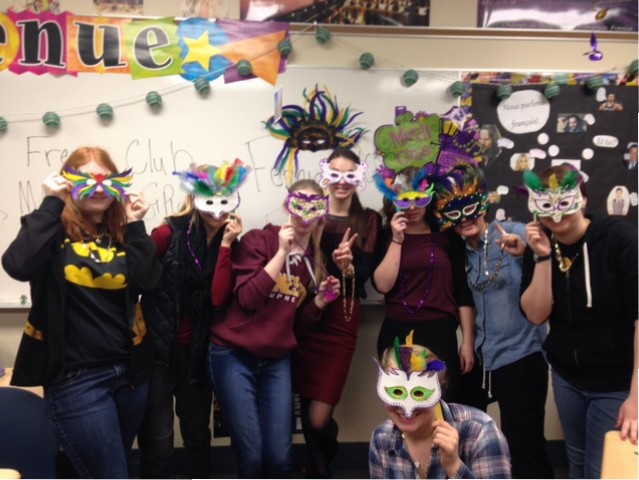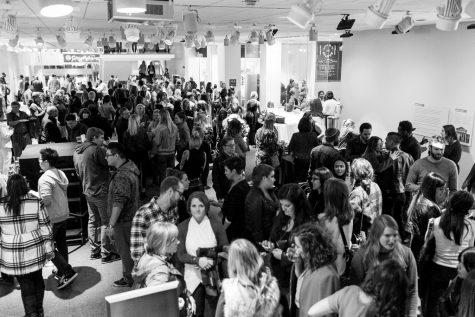Exploring the World Through AVHS
AVHS French students celebrate Mardi Gras on February 9th.
21% of people ages 5 to 17 speak a second language in the United States. Compared to the 80% of students living in Europe, the gap is hard to miss. Bilingualism is spreading throughout Eurasia and is becoming acknowledged as an invaluable asset to students. Due to their historical and regional complexity, locals are capable of speaking up to three languages.
AVHS students have the chance to take German, French, Japanese, or Spanish. This opportunity gives the students a chance to broaden their cultural knowledge and their linguistic minds. “Learning a language is more than learning the words and grammar, it’s about learning the culture and the different ways of seeing life,” says AVHS Japanese teacher Mrs. Moy.
Other than looking good on a college application, learning a foreign language has many benefits that include the development of the brain and a whole new prospect during traveling experiences. “One of the reasons I studied French was because I not only was good at it, but I also got the travel bug and wanted to have all the opportunities that came with speaking French,” says AVHS French teacher Mrs. Godfread.
Learning a new language improves conversational abilities, study skills, concentration and focus, and a greater mastery of languages in general. A study performed by Dr. Thomas Bak noted that being bilingual improves brain function and leads to an improved health throughout your life.
As a language learner, a student will be able to increase their mental health and their global perspective. Students are not limited to learning conjugations, but will also gain knowledge from discovering fascinating traditions and learning cultural values. “We, as teachers, want to indulge them to see a new point of view. So basically for me I think it opens the mind and perspective, it makes them not just an American but a world citizen,” says Mrs. Moy.
Almost 50% of the world is bilingual and most of that is concentrated in Europe. According to the 2012 Eurobarometer, Luxembourg holds the most multilingual population at 84%. Almost 90% of its population is bilingual, followed by Latvia, the Netherlands, Malta and the UK.
Asia is yet another continent that strongly believes in a bilingual society. Students go to a compulsory language class in order to perfect their foreign languages. Encouraged since elementary school to learn another language, many countries have adopted the ideology that a bilingual child is a successful one.
Shattering the language barrier will help students connect with more individuals. Instead of stumbling over hand gestures and confused stares, students are able to hold a conversation all around the world. “I would hate to not be able to have a simple conversation and befriend a person just because of a language difference,” AVHS junior Nan Nongnuang says. “That would definitely be a missed opportunity.”
Another benefit of being a part of a language class would be the tight-knit bonds that develop between fellow classmates and their teacher. “Being in the same German class since freshman year has given me a chance to grow closer with my classmates and my teacher,” says AVHS junior Aisha Salad.
AVHS has a wide range of language clubs covering German, French, Japanese, and Spanish. They interlace traditions and culture into students while giving them a strong desire to explore the background of these countries. “Having a language club is an amazing advantage, in my opinion, because it gives students the ability to learn more of the country and get a clearer sense of the culture,” says Aisha Salad.

“New Year’s is an important time for Japanese students and the Japanese club, where we do calligraphy,” says Mrs. Moy. “We cook during class and after school; so far we made takoyaki and watched a tea ceremony done by a friend of mine.”
The German, French, Japanese, and Spanish clubs celebrate festivals, not to mention the variety of food from each country. From Oktoberfest to Mardi Gras, students learn about the experiences in different countries.
The French club celebrated Christmas with a traditional yule log cake, the German club made mouthwatering gingerbread houses, the Japanese club will venture out to the United Noodle in Minneapolis, and the Spanish club will indulge in Flag Day and Carnival. Furthermore, the language department hosts a volleyball game and a soccer game throughout the school year to add some competition in the mix.
The characteristics of each region is represented through both the classes and the clubs. The teachers push the students to explore the options and delve into the languages. However, they teach beyond the words and implement traditions throughout their day, connecting everyone under one language and making sure the U.S. is able to enrich its students just as well as any country…if not better.








